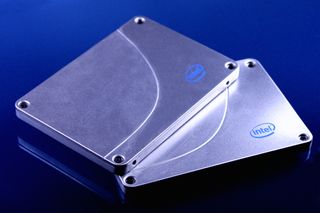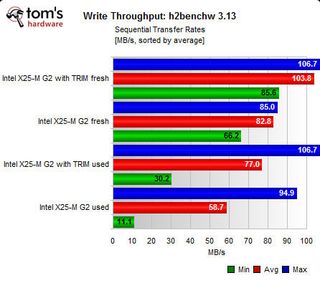Solid State Drive Buyer's Guide
Should you consider upgrading to a solid state drive? Weigh all the pros and cons and evaluate the cost and value of doing so by reading this guide.
MLC Makeover
After all of that talking up, we’ll risk being anticlimactic and say that the days of SLC could be numbered. Even Intel, the current leader in SSD sales, has backed off from its SLC-based drive messaging in recent months, perhaps in an effort to appease recession-strapped businesses. We’re hearing more about MLC in the enterprise these days. Some of it may have to do with price, but some of it is because MLC has made some significant improvements.

We mentioned earlier that SSD drives, and MLC models in particular, tended to lose their luster on write operations. This is largely because of the odd there-and-back process SSDs use when writing. Even if you only want to write a small amount of data to an SSD, say 8KB, the system has to send a 128KB stack of data to system memory. Of that 128KB, 8KB gets replaced with the desired data, then the whole 128KB wad gets sent back to the SSD. (Additionally, whereas read operations can simply assess the value of a cell in a single operation, writes to cells that have already been written once require an erasure of the cell before writing in the new data–two steps instead of one.) The difference between 8KB and 128KB is known as write amplification. All of that extra data being moved about takes more time.
Recently, though, SSD manufacturers have started updating their drive firmware with new algorithms that markedly reduce the size of the data block being sent to and from system memory. The effect on drive performance isn’t night and day different, but it helps.
Another recent enhancement is the TRIM command. TRIM solves the problem of SSDs getting progressively slower as blocks get written to. There’s an inherent mismatch in the way that operating systems and SSD controllers have tracked how and when data gets deleted. Resolving this mismatch usually happens in the drive’s cache, but it takes a lot of extra time. The TRIM command resolves certain elements of this mismatch and improves overall performance.

The catch is that the TRIM command must be supported by both the drive controller and the operating system. Windows 7 and Linux 2.6.28 both support it, as do an increasing number of controllers. Some SSD drives are firmware-upgradeable to support TRIM, some aren’t. Definitely check on this point before committing to a purchase and, after you purchase, refer back to the vendor’s support pages periodically for firmware updates. TRIM is still a recent advance, complete with plenty of speed bumps during early deployment, and will be prone to fine-tuning.
Sign up to get the BEST of Tom's Guide direct to your inbox.
Get instant access to breaking news, the hottest reviews, great deals and helpful tips.
Current page: MLC SSDs Have Drawbacks, but Are Here to Stay - Tom’s Guide
Prev Page SSD Endurance - SLC Has 10x the Lifespan of MLC - Tom’s Guide Next Page SSD vs. HDD - Pros and Cons of Solid State Drives - Tom’s GuideWilliam Van Winkle is a freelance editor and tech journalist who has been writing for more than 20 years. His work has appeared on Tom's Guide, Tom's Hardware, Tom's IT Pro, AMD, Seagate, Computer Shopper, and more. He is also an author, writing poetry, short stories, and science fiction and fantasy books.
-
Shadow703793 Imo, I'd keep away with any SSD drive using a JMicron. Dosen't matter if the stutering,etc issues were fixed. Indylinx and Intel controllers are the best right now.Reply
Anyways, I got an X25-M G2 (OEM) for $220 @Newegg during Black Friday. -
grimjester The point about getting a small SSD for software and a larger disk for data can't be stressed enough. The price per GB looks completely different if you only need 64G. There's little difference in price between the cheapest hard drive you can get and the cheapest 500G one.Reply
An SSD is just an extra cost of $150-300. It has no practical effect on the storage space your computer has. -
Eggrenade I wouldn't say it's better than Anandtech's; there's no mention of random reads or writes, which is why performance just after startup is so good. It's also a lot less technical, which is probably better for most Tom's Guide readers.Reply -
Tomsguiderachel EggrenadeI wouldn't say it's better than Anandtech's; there's no mention of random reads or writes, which is why performance just after startup is so good. It's also a lot less technical, which is probably better for most Tom's Guide readers.Exactly :)Reply -
Tomsguiderachel nonxcarbonxThis is an even better ssd article than anandtech's ssd anthology. Nice work.Thank you. I hope it was a good fit for Tom's Guide readers' needs.Reply -
Next page broken http://www.tomsguide.com/us/ssd-value-performance,review-1455-11.html, sorry couldnt find anywhere to submit feedback. Page not working on firefox 3.5.5 (does not scroll).Reply
-
Tomsguiderachel none007Next page broken http://www.tomsguide.com/us/ssd-va 55-11.html, sorry couldnt find anywhere to submit feedback. Page not working on firefox 3.5.5 (does not scroll).I'm using the same browser and that page works for me. I will report the bug, thanks.Reply -
Tomsguiderachel TomsguiderachelI'm using the same browser and that page works for me. I will report the bug, thanks.Oh--I see that you mean the final page of the article not the penultimate page. FYI There is no content on that last page so you didn't miss part of the article.Reply -
tommysch I think Ill stick to my 4x1TB RAID 0 array for now. BTW they are ghosted each week. o_0Reply
